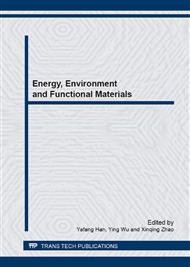[1]
M. S. Dresselhaus, G. Dresselhaus,Intercalation compounds of graphite. Adv. Phys. 51(2002) 1-186.
Google Scholar
[2]
T. Enoki, M. Suzuki, M. Endo, New York: Oxford. 2003. Reference to a chapter in an edited book: Graphite intercalation compounds and applications.
Google Scholar
[3]
H. S. Cheng, X. W. Sha, L. Chen, A. C. Cooper, M. L. Foo, G. C. Lau, W. H. Bailey, G.P. Pez, An Enhanced Hydrogen Adsorption Enthalpy for Fluoride Intercalated Graphite Compounds. J. Am. Chem. Soc. 31(2009) 17732-17733.
DOI: 10.1021/ja907232y
Google Scholar
[4]
J. C. Tsang, M. Freitag, V. Perebeinos, J. Liu, P. H. Avouris, Doping and phonon renormalization in carbon nanotubes. Nature Nanotech. 2 (2007) 725-730.
DOI: 10.1038/nnano.2007.321
Google Scholar
[5]
A. Grüneis, C. Attaccalite, A. Rubio, D. V. Vyalikh, S. L. Molodtsov, J. Fink, R. Follath, W. Eberhardt, B.Büchner, T. Pichler, Angle-resolved photoemission study of the graphite intercalation compound KC8: A key to graphene. Phys. Rev. B 80 (2009) 075431-075435.
DOI: 10.1103/physrevb.80.075431
Google Scholar
[6]
S. Pisana, M. Lazzeri, C. Casiraghi, K. S. Novoselov, A. K. Geim, A. C. Ferrari, F. Mauri. Breakdown of the adiabatic Born-Oppenheimer approximation in graphene. Nat. Mater. 6 (2007) 198-201.
DOI: 10.1038/nmat1846
Google Scholar
[7]
T. E. Weller, M. Ellerby, S. S. Saxena, R. P. Smith, N. T. Skipper, Superconductivity in the intercalated graphite compounds C6Yb and C6Ca. Nature Phys. 1(2005) 39-41.
DOI: 10.1038/nphys0010
Google Scholar
[8]
J. Hwang, J. P. Carbotte, S. Tongay, A. F. Hebard, D. B. Tanner, Ultrapure multilayer graphene in bromine-intercalated graphite. Physical Rev. B 84(2011) 041410-041413.
DOI: 10.1103/physrevb.84.041410
Google Scholar
[9]
S. Tongay, J. Hwang, D. B. Tanner, H. K. Pal, D. Maslov, A. F. Hebard, Supermetallic conductivity in bromine-intercalated graphite. Physical Rev. B 81(2010) 115428-115433.
DOI: 10.1103/physrevb.81.115428
Google Scholar
[10]
S.Tongay, T. Schumann, X. Miao, B. R. Appleton, A. F. Hebard, Tuning Schottky diodes at the many-layer-graphene/semiconductor interface by doping. Carbon 49 (2011) 2033-2038.
DOI: 10.1016/j.carbon.2011.01.029
Google Scholar
[11]
A. C. Crowther, A. Ghassaei, N. Jung, L. E. Brus, Strong charge-transfer doping of 1 to 10 layer graphene by NO₂. ACS Nano 6(2012) 1865-1875.
DOI: 10.1021/nn300252a
Google Scholar
[12]
W. J. Zhao, P. H. Tan, J. Liu, A. C. Ferrari, Intercalation of Few-Layer Graphite Flakes with FeCl3: Raman Determination of Fermi Level, Layer by Layer Decoupling, and Stability. J. Am. Chem. Soc. 113(2011) 5941-5946.
DOI: 10.1021/ja110939a
Google Scholar
[13]
Y. Zhang, Z. X. Zhang, T. B. Li, X. G. Liu, B. S. Xu, XPS and XRD study of FeCl3–graphite intercalation compounds prepared by arc discharge in aqueous solution. Spectrochimica Acta Part A 70 (2008) 1060–1064.
DOI: 10.1016/j.saa.2007.10.031
Google Scholar
[14]
X. Q. Meng, S. Tongay, J. Kang, Z. H. Chen, F. M. Wu, S. S. Li, J. B. Xia, J.B. Li, J. Q. Wu, Stable p- and n-type doping of few-layer graphene/graphite, Carbon 57(2013)507-514.
DOI: 10.1016/j.carbon.2013.02.028
Google Scholar
[15]
Z. R. Ismagilov, A. E. Shalagina, O. Yu. Podyacheva, A. V. Ischenko, L. S. Kibis, A. I. Boronin, Y. A. Chesalov, D. I. Kochubey, A. I. Romanenko, O. B. Anikeev, T. I. Buryakov, E. N. Tkachev, Structure and electrical conductivity of nitrogen-doped carbon nanofibers, Carbon 47(2009) 1922-1929.
DOI: 10.1016/j.carbon.2009.02.034
Google Scholar
[16]
A. Das, B. Chakraborty, S. Piscanec, S. Pisana, A. K. Sood, A. C. Ferrari, Phonon renormalization in doped bilayer graphene. Phys. Rev. B 79 (2009) 155417-155423.
DOI: 10.1103/physrevb.79.155417
Google Scholar
[17]
A. C. Ferrari, J. Robertson, Interpretation of Raman spectra of disordered and amporphous carbon. Phys. Rev. B 61(2000)14095-14107.
DOI: 10.1103/physrevb.61.14095
Google Scholar
[18]
S. Piscanec, S. Piscanec, M. Lazzeri, F. Mauri , A. C. Ferrari, J. Robertson, Kohn anomalies and electron-phonon interactions in graphite. Phys. Rev. Lett. 93(2004) 185503-185506.
DOI: 10.1103/physrevlett.93.185503
Google Scholar
[19]
D. C. Elias, R. R. Nair, T. M. Mohiuddin, S. V. Morozov, P. Blake, M. P. Halsall, A. C. Ferrari, D. W. Boukhvalov, M. I. Katsnelson, A. K. Geim, K. S. Novoselov. Control of Graphene's Properties by Reversible Hydrogenation: Evidence for Graphane. Science 323(2009) 610-613.
DOI: 10.1126/science.1167130
Google Scholar
[20]
S. Tongay, K. Berke, M. Lemaitre, Z. Nasrollahi, D. B. Tanner, A. F. Hebard, B. R. Appleton. Stable hole doping of graphene for low electrical resistance and high optical transparency. Nanotechnology 22(2011)425701-425706.
DOI: 10.1088/0957-4484/22/42/425701
Google Scholar
[21]
C. Thomsen, S. Reich, Double resonant Raman scattering in graphite. Phys. Rev. Lett. 85(2000)5214-5217.
DOI: 10.1103/physrevlett.85.5214
Google Scholar


